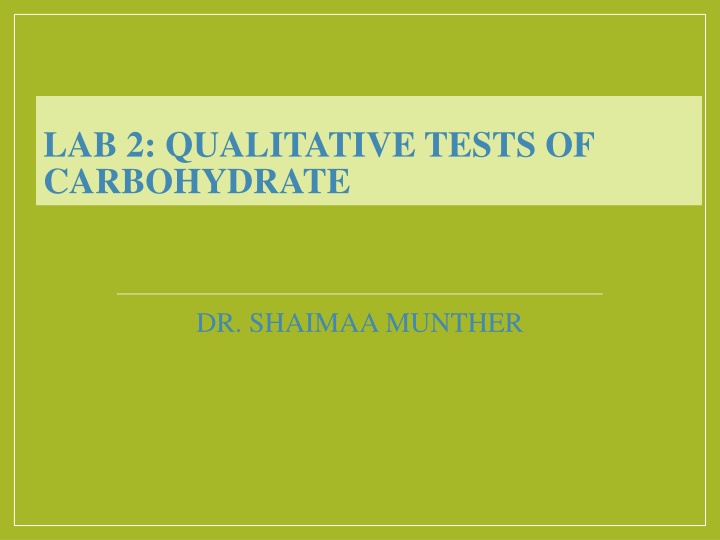
Qualitative Tests of Carbohydrate - Dr. Shaimaa Munther
Explore the qualitative tests for carbohydrates conducted by Dr. Shaimaa Munther, including Benedict's Test and Barfoeds Test. Learn how these tests distinguish between reducing and non-reducing sugars and understand the principles behind each test.
Download Presentation

Please find below an Image/Link to download the presentation.
The content on the website is provided AS IS for your information and personal use only. It may not be sold, licensed, or shared on other websites without obtaining consent from the author. If you encounter any issues during the download, it is possible that the publisher has removed the file from their server.
You are allowed to download the files provided on this website for personal or commercial use, subject to the condition that they are used lawfully. All files are the property of their respective owners.
The content on the website is provided AS IS for your information and personal use only. It may not be sold, licensed, or shared on other websites without obtaining consent from the author.
E N D
Presentation Transcript
LAB 2: QUALITATIVE TESTS OF CARBOHYDRATE DR. SHAIMAA MUNTHER
2. Benedicts Test Benedict's reagent is used as a test for the presence of reducing sugars: All monosaccharides are reducing sugars; they all have a free reactive carbonyl group. Some disaccharides have exposed carbonyl groups and are also reducing sugars. Other disaccharides such as sucrose are non-reducing sugars and will not react with Benedict's solution. Large polymers of glucose, such as starch, are not reducing sugars Objective: To distinguish between the reducing and non-reducing sugars. Application of the test: To detect reducing sugars. It is widely used in detecting glucose in urine even though not specific for glucose.
2. Benedicts Test Principle: The copper sulfate (CuSO4) present in Benedict's solution reacts with electrons from the aldehyde or ketone group of the reducing sugar in alkaline medium. Reducing sugars are oxidized by the copper ion in the solution to form a carboxylic acid and a reddish precipitate of copper oxide. Reddish precipitate of copper Observation: The entire body of the solution will be filled with a precipitate, the color of which varies with the concentration of the sugar solution green, yellow, orange or red. In the absence of reducing substance, blue color of the Benedict s reagent remains as such. The test is sensitive up to 0.1-0.15 gm% of sugar solution (that is Benedict s test will not be Qualitative Analysis 6 positive with solutions containing less than 0.1- 0.15 gm% of sugar).
2. Benedict s Test Benedict s Test Reducing monosaccharides, glucose, fructose, galactose and mannose give a positive reaction with Benedict s reagent. The color of the precipitate give an idea about the concentration of the sugar solution as shown below. Blue : absence of reducing sugar Green : up to 0.5 gm% Yellow : > 0.5 to 1.0 gm% Orange : > 1.0 to 2.0 gm% Brick red: 2 gm% Thus, Benedict s test is described as a semiquantitative test sucrose lactose glucose
PROCEDURE: One ml of a sample solution is placed in a test tube. Two ml of Benedict's reagent is added. The solution is then heated in a boiling water bath for five minutes. Allow the contents to cool by keeping in a test tube rack. A positive test is indicated by: The formation of a reddish precipitate. Tube observation 1-glucose 2-sucrose 3-lactose
3. Barfoeds Test This test is a reduction test performed to distinguish reducing monosaccharides. e.g. glucose, fructose, galactose, mannose Objective: To distinguish between mono- , di- and poly saccharides. Principle: Barfoed s test used copper (II) ions in a slightly acidic medium Reducing monosaccharides are oxidized by the copper ion in solution to form a carboxylic acid and a reddish precipitate of copper (I) oxide within three minutes. Reducing disaccharides undergo the same reaction, but do so at a slower rate. Observation: A red precipitate clinging to the bottom most part of the test tube forms, in the presence of a monosaccharide, the nonreducing sugars give negative result. Barfoed s reagent is copper acetate in acetic acid.
PROCEDURE: Place one ml of a sample solution in a test tube. Add 2 ml of Barfoed's reagent (a solution of cupric acetate and acetic acid. Heat the solution in a boiling water bath for 2 minutes(after the 5-10 min check the tubes). Tube observation 1-glucose 2-sucrose 3-lactose






















